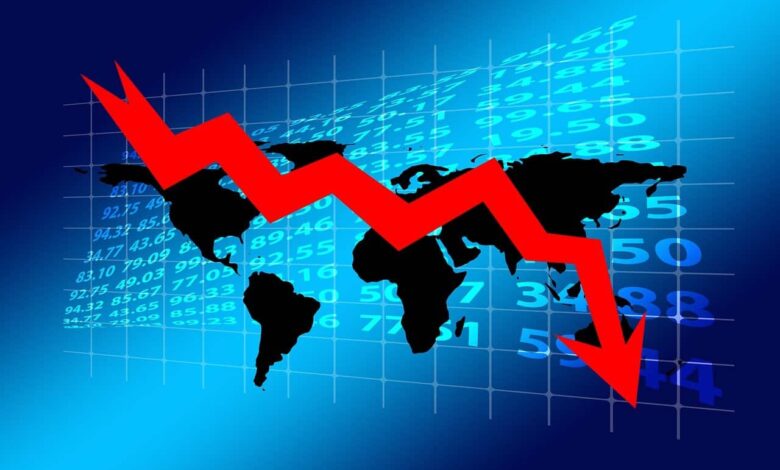Nearly 30% of Bankers Worried about a Severe US & Global Recession

- 30% of bankers fear that the US and world economy is headed into recession, as per a report from The Federal Reserve System
- Declining production and demand, and an inverted yield curve are major reasons behind the expectations
- Several world economies like Germany and the EU are already reeling under economic growth pressure

As per a recent Financial Stability Report from The Federal Reserve System, as many as 30% of bankers are worried about an upcoming US and global recession. The report has sighted the following reasons behind this:
- Persistent inflation and monetary tightening
- Policy uncertainty
- Banking-sector stress
- Market liquidity strains and volatility
- Treasury market dysfunction/basis trade
- U.S.-China and Middle East tensions
Let’s dive deep into some of the most important factors to understand what could impact the economy in the coming few months.
1. Inverted Yield Curve
The 2/10 Treasury yield curve has stayed negative for more than 659 days now, which is a major concern for economists.

Source: ycharts
Usually, higher interest are offered on bonds with longer maturity to compensate for the risk, while short-term bonds yield less. However, when this reverses, we see an inverse yield curve. This means that investors are uncertain about the long-term economic growth of the economy.
The scary part is that this has happened only thrice before. The 1920-1921 recession, the 1929-1932 depression, and the 2008 housing market crash were all preceded by the same inverse yield curve. On all three occasions, it was followed by a 50% stock market crash.
2. Declining Production
A January S&P Global report hints towards declining factory production and depleting demand. The Output Index from S&P Global’s US PMI survey reached a six-month low in December 2023. As per the latest data, production was 2.6% below its pre-pandemic peak.

Source: S&P Global Index
Also, there has been a substantial decline in production backlogs for the last 15 months and new orders have fallen for 16 months of the last 19 months. This hints at declining demand. In fact, the current production is absorbed by past demand and factories may soon have to downsize their capacity.

Source: S&P Global Index
Resultantly, input purchases have also fallen sharply – at the steepest rate since last June with a 17-month continuous decline. This is the longest period during which purchases have fallen in history. The delivery time has also continued to decrease throughout 2023, which indicates a shift from a sellers’ market to a buyers’ one.
PMI’s Employment Index also reveals that factory jobs were cut for a third straight month in December. This is worse than the 2009 economic crisis (barring 2020 pandemic fall).
3. Rising Gold Prices
Gold futures reached an all-time high on 12th April, breaching the $2,400 mark. The prices have surged 15% during the last two months. And increasing gold prices are always a strong indicator of uncertain economic times. Investors perceive gold as a safe haven in times of economic turmoil.

Source: Tradingview
Traditionally gold isn’t a preferred investment instrument as government bonds easily surpass its returns. However, with investors expecting rate cuts in the coming months and bond yields already declining, gold has emerged as a clear winner as of now.
The last big surge was seen between March 2020 and August 2020, when the prices rose by almost 40%. Experts believe that increasing inflationary pressure may push the price even higher in the coming months.
Read more: AI boom will boost copper demand by 1 million tons per annum by 2030
4. Increasing Geopolitical Tensions
An IMF report sheds light on cross-border portfolio and bank allocation in the face of increasing geopolitical tension. China and the US have been having a go at each other for quite some time now.
Such tensions between an investing and a recipient country can affect cross-border capital allocations by as much as 15%.

Source: IMF
The worsening situation in the Middle East and Israel is also a major inflation concern. Any unrest in the Middle East translates into increased oil prices and disrupted supply chains.
This leads to higher energy inflation, which was at 3.5% in March. Increased oil prices also make transportation costlier, increasing the price of consumer goods.
This will also lead the Fed to keep interest rates high longer than expected. When this happens, dollar-denominated assets become more attractive, leading to more foreign capital in the US. However, this is detrimental to other developing economies that see a significant outflow of capital.
5. Global Economies Under Pressure
Several economies around the world have underperformed in 2023, hinting at the possibility of an upcoming global recession.
- Germany is already in a recession, as confirmed by Bundesbank, the country’s central bank. Falling external demand and high borrowing costs stifling domestic investments are cited as key reasons behind the recession.
- African economies have grown at a rate of 3.2% in 2023 as compared to 4.1% in 2022 – a 0.9% decrease. The pandemic, political instability, and the ongoing Ukraine war are all responsible for this slow growth.
- France has also toned down its growth target for 2024 to 1% from 1.4%, including a ten billion euro cut in State expenditures.
6. The EU Nearing Recession
The 20-country eurozone saw a growth of just 0.5% throughout 2023, with a decline of 0.1% in the last quarter of 2023, thereby narrowly escaping technical inflation.
A lot of the credit goes to Novo Nordisk, a pharmaceutical giant based in Denmark. The company made $4 billion worth of sales in the first half of 2023, resulting in the Danish economic growth of 1.7%. In comparison, the entire eurozone grew by just 0.2% during the same period.
If you remove Nordisk’s contribution, Denmark would have seen a 0.3% decline in its GDP and so would the entire eurozone.
This can hardly be said to be any reason to celebrate. The entire EU economy has been stagnant since the third quarter of 2022.
The Bottom Line
All economic indicators point to a single direction – recession. With time, if the Ukraine-Russia or the Iran-Israel situation escalates, we might even get there sooner than expected. The upcoming three months will be crucial in deciding where the economy is headed for the next 3-4 years.
2024 is also a year of elections as half of the world’s population is expected to vote. Major economic powers like the USA, India, Russia, and the UK will go into major elections. The results could bring about changes in monetary policies, and interest rates, and determine the relationship between the nations.
All in all, 2024 is expected to be a year of volatility and uncertainty.

